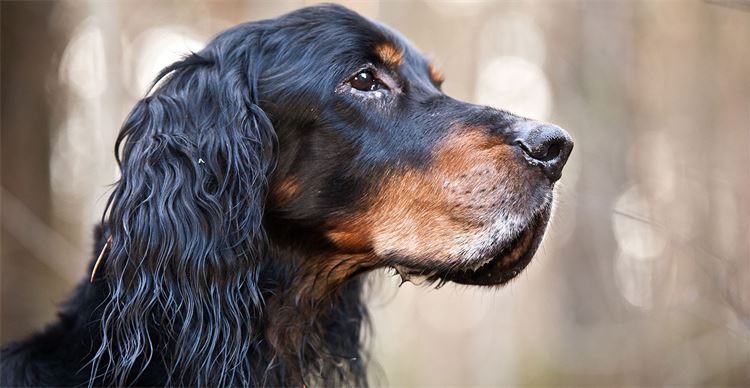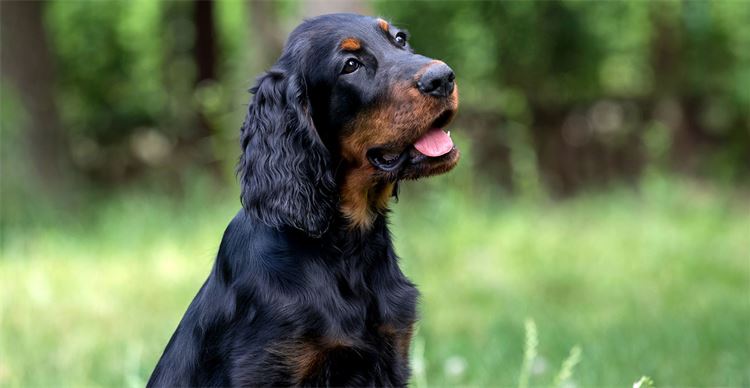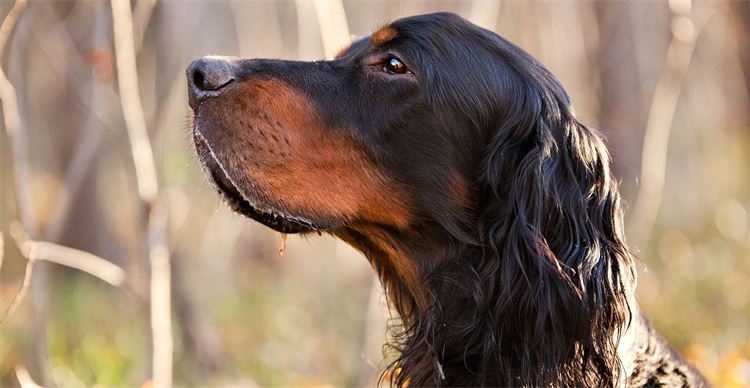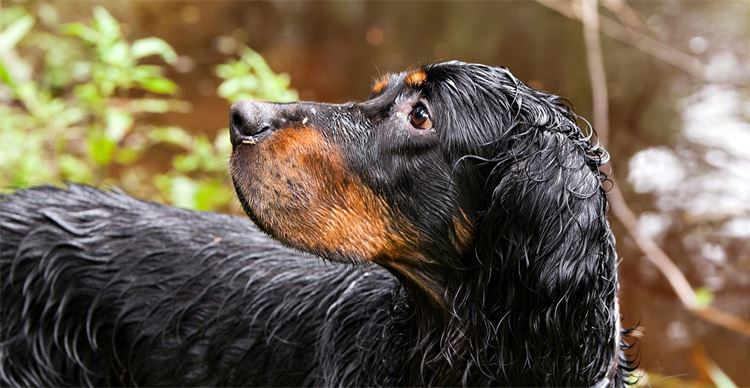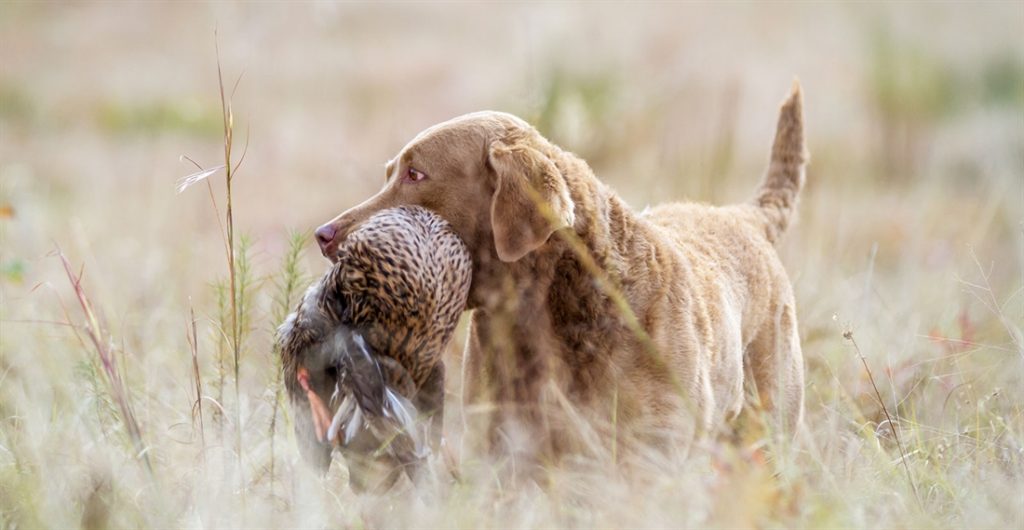A touch of class
The Gordon Setter is a handsome and stylish dog with a characteristic black and tan coat. Tough and hardy, this breed is noted for its intelligence, bold nature and stamina.

It is believed that setters descend from ‘setting spaniels’ developed in the Middle Ages. The first reference to the setting spaniel was written by the French sportsman Gaston de Foix in his work ‘Livre de Chasse’ in the late 1300s. These gundogs were used to hunt wide open terrains for game birds. Once a bird was found the setting spaniel crouched and crawled towards it, allowing the sportsman to throw a net over the dog and quarry. Although modern setters descend directly from these dogs, it’s probable that outside crosses with hounds or pointers were used over the years.
By the 18th century there were several kennels producing a black and tan setter in the British Isles. Alexander, the 4th Duke of Gordon established his kennel at Gordon Castle, north of Fochabers near the Moray coast. Bred to work on the Highland moors, his dogs were valued for their exceptional stamina and gamefinding ability. Originally, the Duke’s dogs were black, tan and white, which made them easier to see while working in heather.
When Alexander died in 1827, the 5th Duke reduced the kennels, giving away dogs to friends and gamekeepers. Nine years later the Gordon estate passed to the 5th Duke of Richmond, who saved the bloodlines and rebuilt a strong kennel of working dogs. Today his descendent, the 11th Duke of Richmond, carries on the tradition and is the honorary president of the British Gordon Setter Club. In 2019 he and his family launched a campaign to help save the breed, inviting Gordon owners from all of the world to the annual Highland Games and Country Fair at Gordon Castle.
Before the invention of the breech-loading gun in 1865, pointers and setters were the most popular shooting dogs in Britain. Many sporting estates maintained large kennels with teams of dogs for visiting guests to shoot over. As driven shooting grew in popularity, shooting over bird dogs for small bags fell out of favour and large estates gradually reduced or sold their kennels.
In 1924 the Kennel Club officially recognised the breed as the Gordon Setter, in honour of the work of the 4th Duke of Gordon to develop the breed. At that time there were 54 black and tan setters registered, and they were mostly bred in Scotland. Throughout the twentieth century the breed was further developed and refined, and breeding kennels spread throughout Britain. During the war years numbers dropped dramatically but, thanks to the work of a few dedicated breeders, numbers gradually regained a firmer foothold by the 1970s.
Today Gordons are again in decline and have recently been designated a ‘vulnerable native breed’ by the Kennel Club. In 2018 there were 172 puppies registered, placing the Gordon Setter at the lower end of the scale for gundogs, behind the Irish Setter, Pointer and English Setter. Only the Irish Red and White Setter had fewer registrations at 51. Despite declining numbers, the Gordon is well represented in both shows and field trials and continues to excel, with several field trial champions made up to date. Although more popular as a family pet, the split between working and show strains has not been as divisive as in many other gundog breeds.
Breed characteristics
The Gordon Setter is a large, tough and hardy dog well suited to cold and windy weather on upland moors in northern England and Scotland. With a noble and dignified bearing, it is slightly heavier and bigger than the other setters and tends to work at a slower pace, although this is less marked in today’s field trial lines. Gordons are noted for their exceptional stamina and are capable of covering more than 50 miles in a day’s work on the grouse moor.
Physically the Gordon is a stylish and handsome dog. It has a coal-black coat with distinctive tan markings of a rich chestnut colour. The coat is medium length and straight, with feathering on the chest, stomach, ears, legs and tail. Its deep head has a long muzzle and large nose, bright brown eyes and low set hanging ears. Its body has a level topline, long neck, sloping shoulders and muscular hindquarters. The tail is long and straight carried horizontally below the line of the back. The gait is steady and galloping with plenty of drive.
They are known to be extremely intelligent with a bold, outgoing temperament, although this often depends on who they’re with. They can be less extroverted than other setters like the Irish Setter and are known to form a strong bond with just one person. As dogs that have been selected to hunt independently, they are curious and headstrong by nature. They are well suited to people with strong personalities that are able to channel their intelligence and establish a bond based on respect. They require firm but gentle handling, and are slow to mature, reaching their prime at about three years.
Although originally bred in large kennels, today Gordons also make good family pets. They require about two hours of exercise a day, and once grown will take as much activity as you’re willing to give them. Both puppies and adults can be very boisterous, so they’re not the best choice for homes with young children. The coat should be groomed more than once a week. With people Gordons have an excellent disposition but can have moments with other dogs, so early socialisation is advised.
The breed is supported and promoted in the UK by four breed clubs and three rescue organisations.
Vet’s corner
The Gordon Setter is on the whole a healthy breed and can lead an active working life for 10 to 12 years, longer than many other gundogs. Like all purebred dogs, there are a few hereditary health conditions that can affect the breed, for which screening schemes and DNA tests are available.
They can be subject to a late onset form of Progressive Retinal Atrophy (PRA), which can lead to loss of sight and blindness. The Kennel Club recommends that breeding stock undergo annual eye tests. The mutated gene has been identified (rcd4) and there is now a breed-specific DNA test to identify carriers and affected dogs.
Gordons are not as prone to hip dysplasia as some other large dogs, but the condition is present within the breed. Breeding stock should be screened under the BVA/Kennel Club scheme. There is a DNA test for Cerebellar Ataxia, a hereditary condition affecting balance and coordination, although so far few dogs have been affected.
Other health conditions to be aware of are bloat, primarily affecting large deep chested dogs, and hypothyroidism. In the latest Kennel Club health survey, based on over 200 dogs, the average life span was 12 years, and the most common causes of death cited were old age and tumours. Amongst living dogs, 103 reported no health problems. The most common health conditions reported in the remaining dogs were skin cysts, lipoma, otitis externa and mammary lumps.
In the field
The traditional role of pointers and setters is to range far and wide over open terrain where game is not plentiful. Gordons are expected to hunt by quartering the ground and, once game is scented, to remain staunchly at point until their handler arrives. They then walk forward next to their handler to flush the bird or birds. They are expected to remain steady to wing and shot, and are not normally asked to retrieve fallen game, although this may happen on the Continent and in America.
As opposed to retriever, spaniel and HPR breeds, setters are expected to work at great distance from their handlers, hunting independently by using their initiative, intelligence and natural abilities. They hold their heads high to use the air to search body scent, rather than low to the ground like a spaniel. To sportsmen and spectators, the work of setters is thrilling and dramatic – the purest and most natural form of gundog work. In the words of the late Graham Cox, “full gallop to seemingly instantaneous immobility is gundog work at its most visceral: the elements laid out on a vast canvas in stark relief. Classic work with bird dogs, it goes without saying, involves much more: but that moment of elevated drama lies elementally at the heart of it.”
There’s nothing like the real thing
Preparing pointers and setters for the field is different from training retrievers, spaniels or HPRs. No artificial means or simulated scenarios, like hunting and retrieving a dummy, can be used. After establishing the basics of early obedience most training takes place in the field, where young dogs have to resist many temptations and work at a distance.
Most handlers begin field training in the spring, when their dogs are about nine months to one year old. At this time game birds are paired, sit tight and are well distributed over the ground, so young dogs have plenty of opportunity to succeed and benefit from favourable scenting conditions. The goal is to teach a dog to use its natural abilities to range wide and fast and quarter the ground in a methodical manner, while remaining responsive to commands and under control. Handling is minimal, carried out mainly by hand signal and whistle to prevent the disturbance of game.
Early on a dog is taught to drop to command; to range and turn to whistle, hand signals and verbal commands; and to be steady to shot, fur and feather. Dogs are walked upwind and taught to range well out on moor or in stubble, turning on command when they reach their ranging limit. They are also taught to completely ignore hares and rabbits, and to drop on command at flush and when a shot is fired.
In the field of competition
Unlike spaniel, retriever and HPR field trials, pointer and setter field trials are mainly held outside the shooting season and no game is shot. The calendar begins in early March, with spring trials held on grouse in Scotland and on paired partridges in young corn in East Anglia. Stakes are again held in July and August before grouse shooting begins, starting in the north of England and working to the north of Scotland on the eve of the Twelfth. Autumn trials are held in early September, mainly on partridges and pheasants in stubble fields in the east of England. The season ends with the annual Champion Stake the second week of September, with the best dogs of the season taking part.
Within this year-round calendar, dogs may be run in 3 or 4 stakes in one week or several times in one month. Up to 45 dogs can compete in a stake, so getting a run is rarely a problem. The atmosphere is friendly and supportive as trials are organised by a small community of enthusiasts who genuinely enjoy the dog work and a day in beautiful scenery.
Stakes are held for all levels of training – puppy (under two years), novice, open and all-aged, in addition to specific breed stakes. At the start of the day a draw is held to establish the running order. Competing dogs are run as a pair or ‘brace’. Two judges assess their work and decide whether or not to call back each dog for a second or subsequent rounds.
Two judges, a referee and a gun walk forward upwind with a handler and dog spaced out at either side so that their work does not overlap. At the judges’ request the dogs are cast off to quarter ahead. When a dog goes on point the handler goes up to it to walk forward with his dog to flush the bird or birds, at which point a blank is fired and the dog is expected to drop. The other dog is expected to back the pointing dog by either coming to point himself, standing still or dropping. If all goes well, the handlers return to the judges and make a new cast.
Judges assess dogs for an overall high standard of work, including excellent pace, stylish work, systematic hunting, firm and positive point and confident flush. Dogs may be discarded for a number of eliminating faults including false points, chasing, bumping (flushing) game, running out of control or making a noise. With so many dogs to be assessed, any dogs that commit a fault or fail to display quality work are quickly discarded, allowing more time to assess successful dogs. It is not uncommon for top awards to be withheld if the work on the day is not satisfactory. Many conditions can influence the outcome of a trial, such as weather, ground and the time of day. An element of luck is always involved, which adds to the excitement and makes the trials more like an actual day of shooting.
Is a Gordon right for you?
Many sportsmen today enjoy several days of driven shooting and will opt for a specialised worker like the retriever or a general-purpose gundog like spaniels and HPRs. But if you like the classic sport of shooting over your dog on upland moors or farmland, where enjoying dog work in beautiful scenery is more important than the size of the bag, the Gordon may be a good choice. This breed is well suited to an active sportsman or handler with a strong personality and experience with other gundogs. With the black and tan you’ll not only have a handsome and stylish worker, you’ll also help save one of Britain’s most distinguished native breeds.
BREED PROFILE
Group
Pointers and Setters
Physical Traits
The largest and heaviest of setter breeds. Black medium-length coat with tan markings. Long muzzle, brown eyes and low set hanging ears. Long neck, sloping shoulders, muscular hindquarters and long straight tail.
Character
Intelligent, bold, outgoing. Curious, independent and strong-minded. Sensitive core that requires firm and fair handling. Slow to mature, remains active and fun loving for life. Excellent disposition with people but can be boisterous with small children. Early socialisation with other dogs recommended. Well suited to large home and garden in the country.
Daily care
Requires two hours of daily exercise and running. Should receive obedience and gundog training. Grooming more than once a week.
Health
Tough and hardy, lives on average 10 to 12 years. Annual eye tests, PRA (rcd4) DNA test and hip dysplasia screening recommended for breeding stock. Some cases of Cerebeller Ataxia. Can be subject to bloat and hypothyroidism.
At work
Noted for stamina, thoughtful work and excellent nose. Well suited to wet and windy conditions of native Scotland. Traditionally used to range far and wide in upland moors and stubble to hunt, point and flush grouse, partridges and pheasants.
Resources
Websites:
britishgordonsetterclub.co.uk
gordonsetterassociation.com
gordonsetterclubofscotland.co.uk
workinggordonsetters.com
Books
The Story of The Gordon Setter (Mildred Adams)
The Field Gordon Setter: The Black and Tan Bombshell (Susanne & Norman Sorby)
Working Pointers and Setters (David Hudson)
Pointer and Setters (Derry Argue)
Related Articles
Get the latest news delivered direct to your door
Subscribe to Gundog Journal
Unlock the full potential of your working dog with a subscription to Gundog Journal, the UK’s only dedicated magazine for gundog enthusiasts. Published bi-monthly, this authoritative resource delivers expert training advice, in-depth interviews with top trainers and veterinary guidance to help you nurture a stronger bond with your dog.
With stunning photography and thought-provoking content, Gundog Journal is your essential guide to understanding, training and celebrating your working dog.
Save 10% on shop price when you subscribe, with a choice of packages that work for you. Choose from Print & Digital or Digital only with each journal delivered directly to your door or via the app every other month, plus access to past issues with the digital back issue library.






